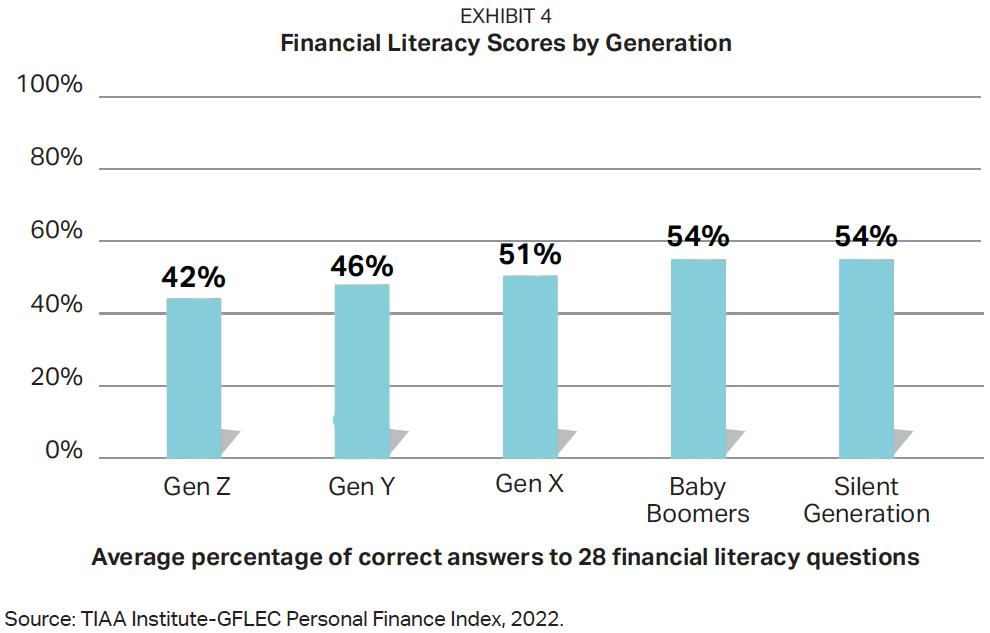Key Takeaways
- Rates of financial literacy—people’s ability to understand various financial-related concepts and put them to use—have fallen significantly in recent years.
- Games, apps and real-life experience can potentially help younger generations enter adulthood with greater financial literacy.
- Parents and grandparents can do a lot to boost literacy—aided by financial advisors.

If you’ve ever suspected that people are more confused than ever about how to save, invest and spend their money, you may be on to something.
It turns out that the percentage of American adults with strong financial literacy—the ability to understand various financial-related concepts and put them to use—has fallen to historically low levels in recent years. For example:
- Just 34 percent of adults showed high levels of financial literacy in 2018—down from 42 percent nine years earlier—based on a financial literacy test offered by the FINRA Investor Education Foundation that asks questions about inflation, interest rates, mortgages and other topics.
- Eight in ten of all respondents in one study were unable to explain what a bond is.
- In particular, our understanding of risk and uncertainty is low—adults on average correctly answered just 36 percent of the questions in another financial literacy study relating to comprehending risk, down from 39 percent a few years earlier.
Other data suggests that our financial literacy has essentially flatlined at a level that’s hardly worth bragging about. One financial literacy study’s overall results have ranged from 49 percent to 52 percent over the past five years—meaning that respondents could answer only about half of the questions.
These and similar findings are prompting more affluent families—as well as educators—to push for greater financial literacy among kids and other young Americans to help reverse recent trends. Consider that 89 percent of people with children say that financial literacy should be a required subject in school, according to Spectrem Group. Indeed, if you have children or grandchildren, there’s likely a lot you can do to instill some financial smarts in your heirs.
With that in mind, here’s a look at steps that can potentially boost financial literacy—and how professionals like your financial advisor as well as technology may be able to help.
Missing an opportunity
An obvious question is what’s driving low (and falling) rates of financial literacy. While there’s little clarity on the issue, it’s noteworthy that a lifetime of experience dealing with financial matters doesn’t seem to make us significantly wiser when it comes to money. As seen in Exhibit 4, older generations didn’t score much higher than younger generations on the same test.

This might be one reason why there’s a disconnect between parents’ and grandparents’ intentions and actions when it comes to money. Consider that the vast majority of adults (83 percent) say parents are primarily responsible for educating their children about money. But 24 percent say they talk to their children about finances less than once a month—and 31 percent never have such conversations at all.
The upshot: If you want your children or grandchildren to be positioned to make smart decisions about wealth, you might want to both bone up on some key financial concepts yourself and set aside time to have discussions. It could be a great opportunity for both of you to study financial ideas together.
Concepts to cover
Another key question to ask is: What concepts do our children need to learn in order for them to be considered financially literate?
The answer, not surprisingly, will differ depending on their age and maybe maturity level. What’s more, there’s an order to these discussions that can help you build on earlier concepts. Starting out by discussing the yield curve with an eight-year-old isn’t likely to get you (or the kid) far—but a talk about saving and investing money for growth might, followed later by running the numbers to show the power of compound interest.
There isn’t a “right” approach suitable for everyone. That said, you probably want to address specific financial concepts—not just values-focused lessons such as the importance of saving money. Your list of important financial topics could look something like this:
1. Unit pricing. Trips to the grocery store are a perfect and natural way to help a child grasp the concept of price per pound, price per ounce and the like, so he or she can see how items that might seem less expensive can actually be more costly over time.
2. Budgeting. Setting up a basic budget can be one of the best ways for kids to wrap their arms around concepts like cash inflows and outflows, necessities versus wants, and emergency funds. Budgeting is actually a concept that some affluent families struggle to teach and hand down to younger generations, particularly if they have enough wealth to consistently take care of all their needs and most of their wants. This is where letting kids get some practical experience—an allowance, a small side business—can make a big impact.
3. Savings yields. Part of the discussion on the importance of having a savings account—and part of the process of setting up that account—can include what a bank or other financial institution will pay you to park your money with them. Compare yields offered by local banks, online banks, CDs and other common vehicles for short-term savings or emergency funds. Then do the math to see how much money you’d have at the end of one year with those various yields. Expand on the topic by discussing the differences in liquidity and access to your funds in these different account types.
4. Credit and borrowing. The allure of credit card spending often starts young—so it’s good to show kids early in their teens how interest charges on balances and cash advances are calculated, and what those charges mean in terms of the real cost of credit card purchases. Discussions about credit and loans might also include the topic of credit scores—their importance and how our behaviors impact them.
5. Equity ownership. Eventually you’ll probably want to impart some facts about how capital markets work and how to tap into their growth potential through equities. The field is wide open here, from basics such as price per share and the pros and cons of direct ownership versus funds to the nuances of capital gains taxes and beyond.
6. Risk and reward. As noted, financial risk is poorly understood by far too many people. And unfortunately, the brain’s ability to accurately assess risk isn’t terribly strong until we hit our 20s. That said, a concept like inflation’s impact on the value of money over time can reinforce earlier discussions about the risks of saving and investing too conservatively. Likewise, the risk of significant short-term losses found among more volatile asset classes may help cement ideas around finding a balance between potential reward and potential risk.
Making lessons stick
Regardless of the specifics, look for ways to engage children on your chosen topics so they want to learn and so the lessons will stick. The good news: There are lots of tools and resources you can tap to make the journey to financial literacy more fun and less like school.
1. Games. Old-school board games such as Payday, Life, Monopoly and others involve taking on debt that must be paid back, deciding whether to purchase insurance (and dealing with the financial consequences if you don’t), choosing whether to go to college or start working right away, and other key financial decisions most of us face in life—in a fun, safe way.
Likewise, there are online and console games that involve the same types of decision-making. One popular example is Animal Crossing, which requires players to navigate the intricacies of mortgages, earning money, managing savings and budgeting, and the risks and reward of investing in turnips via the “stalk market.”
There is some evidence that “gamifying” financial learning for teenagers pays dividends. A 2022 study that looked at the impact of game-based interventions in teaching economics relative to the impact of traditional teaching methods showed that learning outcomes are better with game-based interventions when the relevant measure is economic knowledge.
2. Allowances and side jobs. Having to actually work for dollars can help younger kids and teens realize that money is finite—and prompt them to start paying attention to how they save and spend it. Bonus: Require them to contribute some of the money they earn to nonessential items they want. Having to pay for, say, 25 percent or 50 percent of a video game can help kids better understand the cost of various goods and help them develop a savings and budgeting plan for their spending goals.
3. Tech tools. Increasingly, parents and kids can access kid-friendly debit cards that can be monitored in real time. Money is added to a child’s account, and the associated app can help track balances and set up savings plans, budgets and even charitable giving goals. Parents maintain control over the account and can limit spending as well as get notified about every purchase made on the card—helping facilitate better conversations about money. Some of these resources also offer child-friendly investment platforms that show users how to size up risks and how compounding over time can boost wealth. Some examples include Greenlight, FamZoo and GoHenry.

Getting help
Despite all that you can potentially do to boost your kids’ financial literacy, you might want to enlist some help. One bit of good news is that more schools are adding financial literacy to their curriculums, thereby providing another avenue for financial learning to sink in. And of course, financial advisors you work with can be great resources for introducing and explaining fundamental financial and investment concepts to younger generations—and potentially setting them on a path to making smart decisions about their wealth in the decades to come.

0 Comments